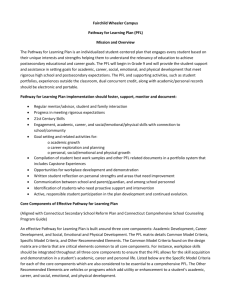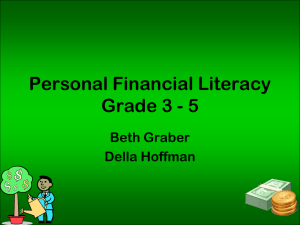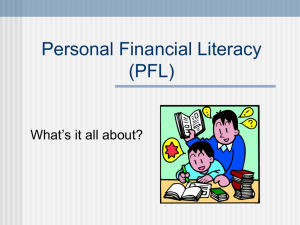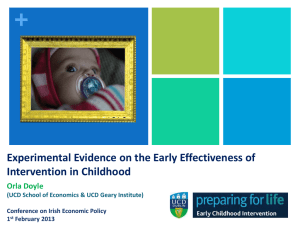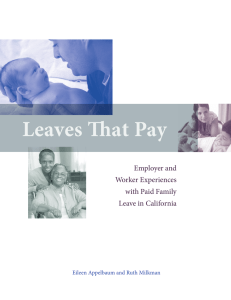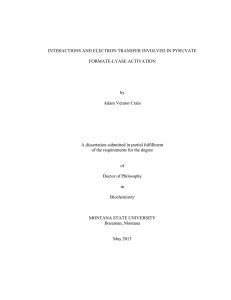M.A. ISSUES IN MODERN CULTURE UCL ENGLISH OPTIONS MENU
advertisement
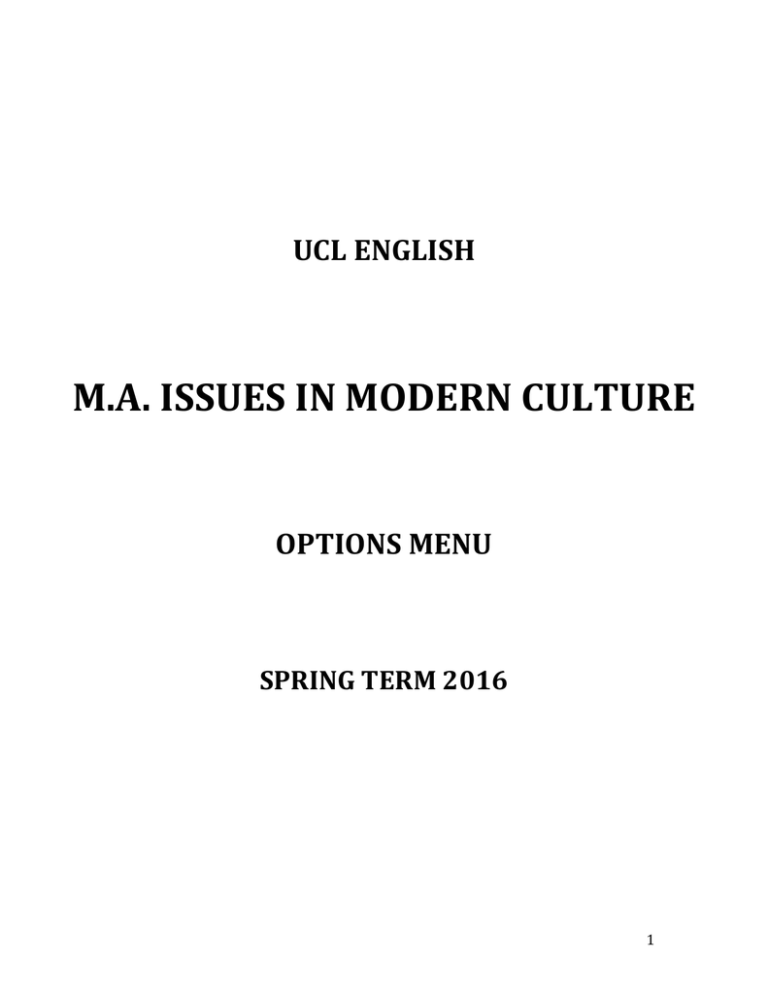
UCL ENGLISH M.A. ISSUES IN MODERN CULTURE OPTIONS MENU SPRING TERM 2016 1 COUNTERFEIT CULTURE: AUTHENTICITY AND ORIGINALITY IN AMERICAN LITERATURE Robert Turner What role is played by authenticity in the literature of the past half century? It has become a critical commonplace that the search for truth and subjectivity, so crucial in the modernist novel, was abandoned in much postmodern literature. Among the “casualties of the postmodern period” recorded by Fredric Jameson was the “existential model of authenticity and inauthenticity”. By contrast, the contemporary age has been marked by the emergence of the so-called “New Sincerity” movement in American prose. This course will re-examine the changing attitudes towards truth and authenticity across the period, mapping the technological, epistemological and political aspects of changing attitudes to originals, copies, and the “Real Thing”. Outline 1. Counterfeit Culture Henry James, ‘The Real Thing’ (1892) Ralph Waldo Emerson, English Traits (1856) Charles Dickens, American Notes (1842) 2. Forgery and Deception William Gaddis, The Recognitions (1955) [excerpts to be provided] Orson Welles (dir.), F For Fake (1974) 3. Technology and Subjectivity Marguerite Young, Miss MacIntosh, My Darling (1965) [excerpts to be provided] Andy Warhol, a: a novel (1968) Mark Twain, ‘A Literary Nightmare’ (1876) 4. Bad History Thomas Pynchon, ‘The Secret Integration’ (1964), included in Slow Learner (1984) William T. Vollmann, The Rifles (1994) Quentin Tarantino, Inglourious Basterds (2009) 5. New Sincerity and Conceptualism 2 David Foster Wallace, Brief Interviews With Hideous Men (1999) Vanessa Place, Statement of Facts (2010) Kenneth Goldsmith, Seven American Deaths and Disasters (2013) Recommended Reading o Roland Barthes, ‘The discourse of history’ (1967), in Keith Jenkins (ed.) The Postmodern History Reader (1997) o Jean Baudrillard, America (1986), trans. Bernard Grasset (1999) o Hal Foster, The First Pop Age: Painting and Subjectivity (2012) o Jonathan Franzen, ‘Mr. Difficult: William Gaddis and the problem of hard-toread books’ (The New Yorker, 30 September 2002) o Kenneth Goldsmith, Uncreative Writing: Managing Language in the Digital Age (2011) o N. Katherine Hayles, How We Became Posthuman: Virtual Bodies in Cybernetics, Literature and Informatics (1999) o Adam Kelly, ‘David Foster Wallace and the New Sincerity in American Fiction’ (2010) o Hugh Kenner, The Counterfeiters: An Historical Comedy (1968) o Friedrich Kittler, Gramophone, Film, Typewriter (1986), trans. Winthrop and Wutz (1999) o Jonathan Lethem, ‘The Ecstasy of Influence: A Plagiarism’ (Harper’s, February 2007) o Miles Orvell, The Real Thing: Imitation and Authenticity in American Culture, 1880-1940 (1989) o Marjorie Perloff, Unoriginal Genius (2010) o K.K. Ruthven, Faking Literature (2001) o Charles Taylor, The Ethics of Authenticity (1991) o Lionel Trilling, Sincerity and Authenticity (1972) o David Foster Wallace, ‘E Unibus Pluram: Television and U.S. Fiction’ (1991) o Robert Anton Wilson, Cosmic Trigger III: My Life After Death (1995) o James Wood, ‘Tell Me How Does It Feel?’ (The Guardian, 6 October 2001) 3 MODERNIST DAYS (and NIGHTS) Nick Shepley This course of seminars sets out to explore the state of the novel at the mid-century, with a particular focus on the one-day (or circadian) novel. It will begin by looking at how shifting notions of time and space (in physics, psychology and philosophy) at the turn of the century were adopted and adapted by canonical modernist writers – such as Joyce, Eliot and Woolf – as ways of experimenting with literary form. We will then look at three authors in detail – Virginia Woolf, Henry Green and Jean Rhys – to think about how their experiments with the one-day novel, at a formal level, can offer us insights into the larger literary, historical and social shifts occurring at the mid-century. The difference, say: between Mrs Dalloway (1925), The Waves (1931) and Between the Acts (1940) – where WWI dominates the first, whilst WWII floods the latter; or the move between city and country in Party Going (1939) and Concluding (1948); or between day or night in Good Morning, Midnight (1939); or between the shifting states of high, late, inter-, postcolonial or post-modernisms in these authors. Finally, we will ask how these shifting modernisms continue to inform and influence literary fiction today. Provisional Outline: 1. Dawn o Joyce, Ulysses (1922) o Eliot, The Waste Land (1922) o Woolf, Mrs Dalloway (1925) 2. Midday: Virginia Woolf o The Waves (1931) o Between the Acts (1940) 3. Dusk: Henry Green o Party Going (1939) o Concluding (1948) 4. Night: Jean Rhys o Good Morning, Midnight (1939) o “A Room of One’s Own”, Virginia Woolf (1929) o Wide Sargasso Sea (1966) 4 5. The Day After the Night Before o Nicolson Baker, The Mezzanine (1988) o Will Self, Umbrella (2012) Recommended Further Reading o Stephen Kern, The Culture of Time and Space 1880 – 1918 (Harvard UP, 2003) o Liesl Olson, Modernism and the Ordinary (OUP, 2009) o Bryony Randall, Modernism, Daily Time and Everyday Life (CUP, 2007) 5 CULTURES OF CHANCE: ACCIDENT, ERROR AND CATASTROPHE IN LITERATURE AND CULTURE FROM 1960 TO THE PRESENT. JULIA JORDAN WEEK 1: INTRODUCTION. Samuel Beckett, Lessness; Images, music and text excerpts from Robert Rauschenberg, Richard Diebenkorn, John Cage, Christine Brooke-Rose WEEK 2: ALEATORY NARRATIVE. B.S. Johnson, The Unfortunates WEEK 3: LUDIC LITERATURE. Sophie Calle, Double Game [images and text provided in class, as the book is quite expensive!]; Vladimir Nabokov, Pale Fire WEEK 4: ACCIDENTAL TEXTS. J.G. Ballard, Crash; Atrocity Exhibition; Critical excerpts from Paul Virilio WEEK 5: 21ST CENTURY CATASTROPHE. Tom McCarthy, Remainder; William Basinski, Disintegration Loops [available on YouTube] Metaphors of chance and the accidental can be said to dominate the post-’45 period of literature and art. In a postwar period characterized by fragmentation, with a backdrop of the new science of uncertainty and the emergence of chaos theory, scientific and cultural disciplines move towards an interest in the competing forces of order and disorder. Indeed, postmodernism itself can be understood as part of this shift, as culture moves away from a modernist mourning for lost meaning and instead begins to articulate an affinity with indeterminism and uncertainty. Novels are broken up to become shuffleable; in the visual arts artists work with found objects, and with paint thrown randomly onto canvases; John Cage and Samuel Beckett let the accidental determine the precepts of their artistic composition. In the period from 1960s to the present, then, chance and the accident become fundamental to cultural production, and this course will investigate the extent to which this is particularly true of post-1960 literature and literary theory. We will read texts that take aleatory precepts as central organizing factors (the shuffleable narrative of B.S. Johnson, the ludic experimentation of Nabokov and Calle, the collisions, crashes and catastrophes of Ballard and McCarthy) and explore concepts such as jouissance and the clinamen. In doing so we will discuss the extent to which the commonly held crisis of representation that seems to take place in this period is fundamentally a crisis of uncertainty, as Robert Coover writes: ‘All of us today are keenly aware that we are undergoing a radical shift in sensibilities. We are no longer convinced of the nature of things, of design as justification. Everything seems itself random.’ 6 Further Reading o Roland Barthes, The Pleasure of the Text (London: Hill & Wang, 1980) o Ross Chambers, Loiterature (Lincoln: University of Nebraska Press, 1999) o Joseph M Conte, Design and Debris: A Chaotics of Postmodern American Fiction (Tuscaloosa, AL: University of Alabama Press, 2002) o Jacques Derrida, ‘My Chances/Mes Chances: A Rendezvous with some Epicurean Stereophonies’, in Taking Chances: Derrida, Psychoanalysis and Literature, eds. o Joseph H Smith and William Kerrigan (Baltimore: Johns Hopkins University Press, 1984) o Raymond Federman, Critifiction: Postmodern Essays (New York: SUNY Press, 1993) o Ross Hamilton, Accident (Chicago and London: University of Chicago Press, 2007) o Catherine Malabou, The Ontology of the Accident (London: Polity Press, 2012) o Jerry A. Varsava, Contingent Meanings: Postmodern Fiction, Mimesis, and the Reader (Tallahassee: Florida State UP, 1990). o Paul Virilio, The Original Accident (London: Polity Press, 2005) 7 MARXIST AESTHETICS IN THE TWENTIETH CENTURY Matthew Beaumont This Option will trace the relationship between politics and aesthetics in the work of the philosophers associated with the Frankfurt School, exploring the early C20 debates about realism and modernism and examining, among other issues, the meanings of the avant garde. In all but the first session, each one will focus on a single, significant essay, often with particular attention to literature. 1. Georg Lukacs et al (debates over realism and modernism in Fredric Jameson ed., Aesthetics and Politics [new edition, 2007]) 2. Walter Benjamin (‘The Work of Art in the Age of Mechanical Reproduction’) 3. Bertolt Brecht (‘A Short Organum for the Theatre’) 4. Theodor Adorno (‘Trying to Understand Endgame’) 5. Ernst Bloch (‘A Philosophical View of the Detective Novel’) Preliminary Secondary Reading o Perry Anderson, Considerations on Western Marxism (1976) o Stephen Eric Bronner, Critical Theory (Very Short Introductions, 2011) o Martin Jay, The Dialectical Imagination (1996) o Eugene Lunn, Marxism and Modernism (1992) 8 FREUD Rachel Bowlby This course provides the opportunity to look at the range of Freud’s writings—its many genres (case history, lecture, polemic, essay; some for specialist and some for general readerships), and its many fields of theoretical and therapeutic exploration: the divided self; sexuality and the development of gender; cultural history and collective psychology; literature, memory and fantasy; everyday life—to name some. Throughout, we will relate the issues and debates evoked in Freud’s texts to present-day arguments about such topics as sexuality and gender; personal and collective memory; ‘modern’ mental disorders and the place of the ‘talking cure’. The following is a provisional outline of the week-by-week topics; all the readings can be found in the 15-volume Penguin Freud Library (‘PFL’). ‘SE’ refers to the 24-volume Standard Edition of the Complete Psychological Works of Sigmund Freud, which is available in paperback; the Penguin texts are taken from this. (Note that—confusingly—there’s also a different collection of more recent Penguin Freud texts, all with different translators.) For those who can make use of it, I’ve also given references to the complete German edition, as ‘GW’ (Gesammelte Werke). The Standard Edition is arranged chronologically, the (numbered) Penguin thematically. So knowing the date of a text will enable you to find it in the SE, but with PFL you have to know if the text you want is there at all, and if so where. Also, the whole of Freud in English is now available online… For each week, the principal reading for seminar discussion is given first. ‘Further Reading’ is additional, if you have time or if you decide to do more work on this topic. Where only the author’s name is given, the reference is to the bibliography. Week 1 Beginning Psychoanalysis Freud, ‘The Psychotherapy of Hysteria’, in Freud and Josef Breuer, Studies on Hysteria (1895), SE 2: 255-305, PFL 3; ‘Zur Psychotherapie des Hysterie’, in Studien über Hysterie, GW 1: 252-312 Further reading: Any of the six case study chapters in Studies in Hysteria, especially ‘Anna O’. Week 2 Presenting Psychoanalysis Freud, Introductory Lectures (1916-17): PFL 1, SE 16-17, GW 11. The following five (all from SE 17) are the ones to concentrate on: XIX Resistance and Repression XXIV Common Neurotic States XXVI Libido and Narcissism 9 XXVII Transference XXVIII Analytic Therapy Further reading: any of the rest of the lectures—and also New Introductory Lectures (1933): PFL 2, SE 22, GW 15 Week 3 Masculinity and Modern Life ‘”Civilized” Sexual Morality and Modern Nervous Illness’ (1908): PFL 12, SE 9, GW 7 ‘A Special Type of Object-Choice Made by Men’ (1910): PFL 7, SE 11, GW 8 ‘On the Universal Tendency to Debasement in the Sphere of Love’ (1912): PFL 7, SE 11, GW 8 Fetishism’ (1927): PFL 7, SE 21, GW 14 Week 4 Women and Other Misfit Narratives ‘The Dissolution of the Oedipus Complex’ (1924), PFL 7, SE 19, GW 13 ‘Some Psychical Consequences of the Anatomical Distinction between the Sexes’ (1925), PFL 7, SE 19, GW 14 ‘Female Sexuality’ (1931), PFL 7, SE 22, GW 14 ‘Femininity’ (1933), PFL 2, SE 22, GW 15 Further reading: Bersani; Bowlby (1992), ch. 8; Brennan (ed.); Mitchell (1974) Week 5 Everyday Madness and Creativity ‘Bungled Actions’, chapter VIII of The Psychopathology of Everyday Life (1901), PFL 5, SE 6, GW 4 (‘Das Vergreifen’) ‘Creative Writers and Daydreaming’ (1908), SE 9: 143-58; ‘Der Dichter und das Phantasieren’, GW VII: 213-26 ‘Family Romances’ (1909), SE 9: 237-41, PFL 7; ‘Der Familienroman der Neurotiker’, GW 7: 227-34 Beyond the Pleasure Principle (1920), ch. II (5 pages on the Fort/Da game): SE 18, PFL 11: 281-7; GW 13 10 Bibliography Janet Beizer, Ventriloquized Bodies: Narratives of Hysteria in Nineteenth-Century France (Ithaca: Cornell UP, 1994) Leo Bersani, Homos (Cambridge: Harvard UP, 1993) Christopher Bollas, Hysteria (London: Routledge, 1999) Rachel Bowlby, Freudian Mythologies: Greek Tragedy and Modern Identities (Oxford: OUP, 2007) Still Crazy After All These Years: Women, Writing and Psychoanalysis (London: Routledge, 1992) Teresa Brennan (ed.), Between Psychoanalysis and Feminism (London: Routledge, 1989) Georges Didi-Hubermann, Invention of Hysteria: Charcot and the Photographic Iconography of the Salpêtrière (1982), trans. Alisa Hartz (Boston: MIT P, 2003) Juliet Mitchell, Mad Men and Medusas: Reclaiming Hysteria and the Effects of Sibling Relationships on the Human Condition (London: Penguin, 2000) Psychoanalysis and Feminism (1973; Harmondsworth: Penguin, 1974) Elaine Showalter, The Female Malady: Women, Madness and English Culture, 18301980 (London: Virago, 1987) 1998) Hystories: Hysterical Epidemics and Modern Culture (1997; London: Picador, 11 21st-Century Fiction Michael Sayeau This seminar will examine novels published during the 21st-century. In particular, we will consider the following issues: - What does it mean to be an ‘avant garde’ writer today? (Is it even possible?) How are writers responding to the internet? How do writers responds to the demands of a changing market for books. How does the ‘professionalisation’ of writing via academia effect contemporary novels? What ethical issues are involved in using the novel to respond to contemporary events? How is the notion of ‘literary’ fiction changing? The reading list for this course is not yet ready, as I like it to deal with very contemporary fiction, some of which I’ll be reading myself for the first time over the summer. We’ll almost certainly cover Karl Ove Knausgaard (probably the most influential writer working today). I’ll have the full list ready by the start of the autumn term. Recommended Secondary Material o David Shields, Reality Hunger o Mark McGurl, The Program Era: Postwar Fiction and the Rise of Creative Writing o Chad Harbach, ed., MFA vs. NYC: The Two Cultures of American Fiction o James Wood on ‘Hysterical Realism’: http://www.newrepublic.com/article/61361/human-all-too-inhuman 12
